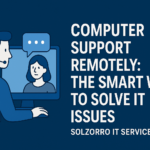In today’s digital-first world, businesses and individuals rely heavily on technology. When technical issues arise, downtime can mean lost productivity and frustration. Traditionally, computer support meant waiting for an on-site technician. But thanks to advances in secure connectivity and cloud tools, computer support remotely has become the new standard.
This article explores what remote computer support is, how it works, its benefits, and when it’s the right choice for your business.
What Is Remote Computer Support?
Remote computer support is a service where IT professionals troubleshoot, diagnose, and resolve computer problems from a different location using secure software tools. Instead of traveling to your office or home, technicians access your system online.
This can include:
- Installing or updating software
- Diagnosing system errors
- Fixing network connectivity issues
- Running security scans
- Guiding users through complex tasks
With remote support, you get fast assistance without the delays of scheduling an on-site visit.
How Does Remote Computer Support Work?
Remote IT support relies on secure connection software that allows a technician to view and control your computer screen.
The typical process looks like this:
- User requests help – A support ticket or phone call initiates the session.
- Secure login – You grant permission for the technician to access your device.
- Problem diagnosis – The technician identifies and analyzes the issue.
- Resolution – The fix is applied directly, or you’re guided through steps.
- Verification – You confirm that the issue has been resolved.
This streamlined approach often solves problems within minutes.
Key Benefits of Remote Computer Support
1. Faster Response Times
Because travel isn’t required, issues can be addressed almost immediately, reducing costly downtime.
2. Cost Efficiency
Remote support eliminates travel expenses and enables technicians to assist multiple clients in less time.
3. Flexibility for Businesses
Whether your workforce is in-office, remote, or hybrid, support can be delivered wherever employees are located.
4. Improved Security
Reputable providers use encrypted connections and strict access protocols to protect sensitive data during sessions.
5. Proactive Maintenance
Many IT providers offer ongoing monitoring, spotting and fixing issues before they disrupt operations.
When Is On-Site Support Still Needed?
While remote computer support solves most issues, certain cases still require an in-person technician:
- Hardware failures (e.g., replacing a hard drive or power supply)
- Complex network installations
- Physical device setup (printers, servers, etc.)
For businesses, a mix of remote and on-site support often delivers the best balance of convenience and reliability.
Why Businesses Choose Professional Remote IT Support
For small and medium-sized businesses, outsourcing IT support is often more efficient than maintaining an in-house team. Providers like Solzorro IT Services deliver remote computer support tailored to business needs, ensuring systems remain secure, compliant, and fully operational.
This allows teams to focus on core business functions instead of troubleshooting tech problems.
Trusted Sources and Best Practices
When considering a provider, always check:
- Security certifications
- Service level agreements (SLAs)
- Compliance with regulations such as HIPAA (if applicable)
For more on remote IT practices, resources like Microsoft Learn and CSO Online provide valuable insights.
FAQs About Remote Computer Support
Q1: Is remote computer support safe?
Yes, when provided by trusted IT companies, remote support uses encrypted connections and limited access to keep your data secure.
Q2: Can all issues be fixed remotely?
Most software and network issues can, but hardware repairs or physical installations still require on-site service.
Q3: Do I need special software for remote support?
Usually, no. The IT provider will guide you to download a secure application that enables temporary access.
Q4: Is remote computer support only for businesses?
No, individuals can also benefit from quick assistance with software, email setup, or virus removal.
Final Thoughts
Computer support remotely has revolutionized how individuals and businesses handle IT issues. With faster response times, cost savings, and strong security measures, it’s a powerful alternative to traditional on-site service. For ongoing IT stability, partnering with a reliable provider ensures you’re covered both remotely and when in-person help is needed.

